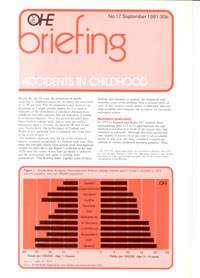Sign up to our newsletter Subscribe
Analysing Global Immunisation Expenditure

During the last 30 years the proportion of deaths occurring in childhood caused by accidents has risen from 21 to 30 per cent. This development is not, however, as disturbing as it might initially appear for it is more a reflection of the…
During the last 30 years the proportion of deaths occurring in childhood caused by accidents has risen from 21 to 30 per cent. This development is not, however, as disturbing as it might initially appear for it is more a reflection of the elimination of infectious diseases from childhood mortality patterns than an indication of trends in accidental fatalities. Over this period the latter have fallen, both in volume terms and as rates per million population aged 1-14 years, by between 40 and 50 per cent. Furthermore, the performance of England and Wales in this particular area is currently one of the best in the world (Figure 1).
Yet fatalities represent only the tip of the iceberg of injuries sustained accidentally by children each year. This point has emerged clearly from several local investigations carried out since the Court Report’s comment in the mid-19705 that ‘the extent of non-fatal accidents is unknown and the professional time spent in treating them unmeasured’. This Briefing draws together some of these findings and attempts to quantify the magnitude and economic costs of the problem from a national point of view. It also reviews recent trends in both fatal and nonfatal accidents and examines the prospects for successful preventive action.
Accidents in childhood
Wells, N.
(1981) Accidents in childhood. OHE Briefing. Available from https://www.ohe.org/publications/accidents-childhood/